Table of Contents
1. Components
9. New Yorkers
2. Game Setup
10. Tokyoites
3. Play Cards
11. Parisians
4. Buy Cards
12. Londoners
5. Using Patron Powers
13. Singaporeans
6. End the Round
13. Solo Rules
7. End the Game
15. FAQ
8. Patron Glossary
16. Credits
Your eccentric collection of avant-garde art needs a public show!
Hone your collection by purchasing art that attracts patrons with special powers to help you assemble the best exhibition!
Every piece in your collection means more strategies to use each round.


2 Hidden Gem Tokens

5 Change Tokens

First Player Token
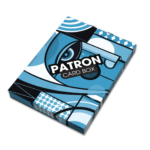
1 Patron Card Box
18 Advanced Patrons

Gallery Card Box
- 12 Twos
- 12 Threes
- 12 Fours
- 8 Fives
- 8 Sixes
- 8 Sevens
- 32 Awards

Starter Deck Card Box
![]() Orange/Blue deck (10 Cards)
Orange/Blue deck (10 Cards)
![]() Red/Purple deck (10 Cards)
Red/Purple deck (10 Cards)
![]() Red/Blue deck (10 Cards)
Red/Blue deck (10 Cards)
![]() Orange/Purple deck (10 Cards)
Orange/Purple deck (10 Cards)
![]() Red/Orange deck (10 Cards)
Red/Orange deck (10 Cards)
-
Unroll the Starter Deck Box. Give each player 1 of the 5 starting decks. Put the others away.
-
Unroll the Gallery Box and the Patron Box. Arrange them like this:
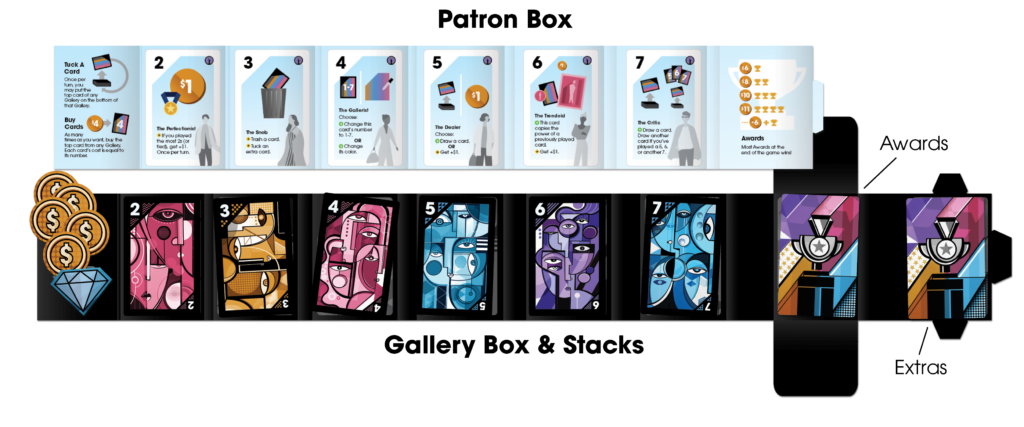
-
Shuffle each Gallery Card Stack, then return it to its position number side up. The first stack is all 2s, the next stack is all 3s, etc.
-
Move some awards from the Awards Stack to the Extras Stack beside it, based on the player count:
2-3 Players
4-5 Players
24 Awards, 8 Extras
28 Awards, 4 Extras
-
Put out the Change Tokens and a Hidden Gem Token (or 2 Hidden Gem Tokens for 4-5 players).
-
Give a random player the First Player Token.
-
Each player shuffles their deck and draws 7 cards from it to form their hand. You’ll have 3 cards left in your deck for next round. You’re ready to begin!

Great exhibitions earn awards!
Each turn that you earn $6 or more, you’ll get an award.
The game ends when the awards run out, and whoever has the most awards wins!

Rounds have 2 parts:
First, everyone Plays Cards at the same time.
Then each player has a turn to Buy Cards.
1. Play Cards
-
Simultaneously, each player lays out as many cards as they can from their hand in a line in front of them:
-
Look at your hand of 7 cards.
-
Choose a card to start, and play it on the table in front of you, number side up.
-
Now, each card you play must match the color or the number of the previous card you played.
-
Play as many cards as you can! Each card you play will be worth $1!
-
Discard the rest of your hand number side up beside your deck to form your discard pile.
The other players will be playing their own line of cards at the same time.
Don’t look at what they are playing until you’re done!
Playing Cards Example
Olivia’s hand has these cards:

She plays these cards (below) in order on the table, for a total of $5:


Tip: Your white 1 ( ) and your gray 2 (
) and your gray 2 ( ) are different colors, and do not match each other. They are hard to match.
) are different colors, and do not match each other. They are hard to match.
Starting with the first player take turns shopping for new cards to improve your deck. On your turn:
-
Count the cards you played this turn. You earn $1 per card. Keep count of your money in your head (don’t use the Change Tokens).
-
Buy cards from the top of the Gallery Stacks. The 2s cost $2, 3s cost $3, etc. Put cards you buy in your discard pile—they’ll go in your deck soon.
Before, after, or between buying cards, in any order:
Patron Powers: Use the 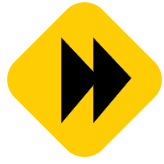 patron powers of cards numbered 2-7 you played this turn (see Patron Powers). On your first turn, the only power you could have is the 2s power, below:
patron powers of cards numbered 2-7 you played this turn (see Patron Powers). On your first turn, the only power you could have is the 2s power, below:
Tuck (once per turn): Put the top card of the Gallery Stack on the bottom of that stack, in the hopes of finding a color you want more.
Tip: Choose a couple of colors to go for. Try to buy cards of only those colors so you match more!
EARN AWARDS
If you made at least $6, you also earn awards (for free)! Take them from the Awards Stack and add them to your score pile. More money earns more awards:
$6
$8
$10
$11
Every additional $6
1 Award
2 Awards
3 Awards
4 Awards
+1 Award
Sometimes you get extra money from patron powers, Hidden Gems, and Change Tokens (see below). These all count toward your total for awards!
END OF TURN
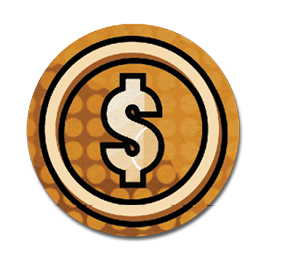
Your leftover money goes away. If you didn’t spend it all, take 1 Change Token. You can only ever have one. On a future turn you can spend the Change Token to get +$1. You can’t take a Change Token if you spent one this turn.
BUYING CARDS EXAMPLE:
Olivia played 6 cards, and had the most 2s. She has $7: $1 per card, +$1 for the 2s patron power.
She buys the top 3 for $3, adding it to her discard pile. She tucks the top 2 , then buys the next 2 for $2. Then she takes 1 award because she had $6+ total.
With $2 left, she takes a Change Token to use later.
Each Patron has a number, 2-7. When you play a card with their number, they visit your exhibition and grant you a special power this turn. Buy cards with patrons whose powers work together!
When you play a 2-7, check the corresponding patron shown on the Patron Box, and you may use its power. The icon next to each power’s description will tell you when it activates.
These powers activate during Play Cards, as soon as you play the card (like 4s and 7s).
You use these powers on your Buy Cards turn.
Check the Patron List booklet for details about each power (and the advanced patrons).
As Olivia plays her  , she uses its
, she uses its  patron power to change its number to a 1. Now it matches her previous card. On her turn to buy she has $6. She uses the
patron power to change its number to a 1. Now it matches her previous card. On her turn to buy she has $6. She uses the  power of her two 3s to trash the
power of her two 3s to trash the  and the
and the  .
.

Once everyone has taken their turn to buy:

-
Pass the First Player Token to the left.
-
Put all the cards you played into your discard pile, number side up.
-
Draw 7 cards from your deck.
-
When you need to draw a card but your deck is empty, flip your discard pile over and shuffle it to form your new deck. (Just like other deckbuilders!)
Shuffling Example
At the end of round 1, draw 3 cards from your deck. Then it will be empty. Flip and shuffle your discard pile to form your new deck, then draw 4 more cards from it.

-
The player with the fewest total awards takes a Hidden Gem Token, worth +$1. For 4-5 players, the next lowest player takes the other Gem. If more players are tied than there are Gems, no one gets those Gems (like when everyone has 0 awards).
-
Start the next round with Play Cards.
Beginners’ Shuffling Variant
At the end of round 1, draw 3 cards from your deck. Then it will be empty. Flip and shuffle your discard pile to form your new deck, then draw 4 more cards from it.
When a player takes the last award from the Awards Stack, the game will be over at the end of the round. Keep going until everyone has taken their turn.
Once the Awards Stack has run out, players can take awards from the Extras Stack for the rest of the round. If those run out, use anything to represent more extras.
The player with the most awards wins! If tied, the tied player who made the most money this round wins.
Cleanup
-
Return all 10 cards with your starting deck symbol (
 ) to their place in the Starter Deck Box.
) to their place in the Starter Deck Box. -
Return all remaining cards to their Gallery stacks in the Gallery Box. Then roll up the boxes!
Patron Details
Each patron power is explained in detail below. We recommend that you play with the New Yorker patron powers for your first few games as it’s the easiest to learn.
In future games, you can replace the New Yorker powers with the powers of the Tokyoite or Parisian patron sets. If you have the Avant Carde’s Micro Expansion you will also have a fourth patron set: The Londoners.
 NEW YORKERS
NEW YORKERS
2 – The Perfectionist
 On your turn to buy if you have the most 2s (or tied), you get an additional +$1 this turn to buy cards with, once per turn.
On your turn to buy if you have the most 2s (or tied), you get an additional +$1 this turn to buy cards with, once per turn.
(Unlike the other powers, you may only use this once per turn, not once per 2.)

Example
You play ![]()
![]()
![]()
![]()
![]()
![]()
![]() . At the start of your turn to buy, you have $7 because you played seven cards. You played more 2s than any other player, so you use the power of one of your 2s and get +$1, for a total of $8 to buy with.
. At the start of your turn to buy, you have $7 because you played seven cards. You played more 2s than any other player, so you use the power of one of your 2s and get +$1, for a total of $8 to buy with.
When do I check to see if I have the most 2s?
You check if you have the most 2s (or are tied for most 2s) on your turn to buy, when you choose to use the 2’s patron power.
In rare cases, the number of 2s players have may change between turns (for example, if they used the Snob to trash a 2 they played). When you check, you check only the 2s that players have in front of them among the cards they played—so if another player trashed a 2 before your turn, they have one fewer when you count 2s.
It’s possible for an opponent to have the most 2s on their turn, and you to have the most 2s on your turn.
3 – The Snob
 On your turn to buy, choose any card from your discard pile or cards you played and trash it (return it to the box). Great for removing unwanted cards.
On your turn to buy, choose any card from your discard pile or cards you played and trash it (return it to the box). Great for removing unwanted cards.
 You may also tuck an extra card in the Gallery.
You may also tuck an extra card in the Gallery.

Example
You play ![]()
![]()
![]()
![]() . At the start of your turn to buy, you get $4 because you played 4 cards. You use your 3’s power to trash your 12, returning it to the box.
. At the start of your turn to buy, you get $4 because you played 4 cards. You use your 3’s power to trash your 12, returning it to the box.
You use your 3’s second power to tuck a card in the Gallery.
Why would I trash cards? Which should I trash?
Trashing cards lets you remove them from your deck so you draw cards with patron powers more frequently.
You should use this power to get rid of cards that are hard to match or have no patron powers.
Good cards to trash include your ![]()
![]() (because you can’t buy any other white or gray cards), or your 11-14 cards (because you can’t buy any other 11-14 cards, and they have no patron powers).
(because you can’t buy any other white or gray cards), or your 11-14 cards (because you can’t buy any other 11-14 cards, and they have no patron powers).
What happens if I trash a card I played?
If you choose to trash a card you played instead of trashing one from your discard pile, you keep its money (because you get money at the start of your turn to buy).
You can choose to use your ![]() powers in any order. If the card you wish to trash has a
powers in any order. If the card you wish to trash has a ![]() power, you may choose to use it before you use your 3’s power to trash it.
power, you may choose to use it before you use your 3’s power to trash it.
Can I trash a card from my hand?
Yes—well, kinda.
You have to discard all cards remaining in your hand before your turn to buy. So when you use your 3’s power, you can trash a card that was in your hand (and is now in your discard pile).
Do I have to trash a card?
No, all patron powers are optional.
Can I trash a 3 with its own power?
Yes!
Can I tuck an extra card before I trash a card?
Yes! You can use your ![]() patron powers in any order!
patron powers in any order!
You can even tuck an extra card, use a different card’s ![]() power, and then come back and trash a card.
power, and then come back and trash a card.
4 – The Gallerist
 The 4s are wild! As you play a 4, you may change its number to 1-7 OR its color to orange, red, blue, or purple. The changed 4 must match your previous (and next) card. Changing its number doesn’t change its powers.
The 4s are wild! As you play a 4, you may change its number to 1-7 OR its color to orange, red, blue, or purple. The changed 4 must match your previous (and next) card. Changing its number doesn’t change its powers.

Example
You want to play ![]() . As you play your 4, you say you’re changing it to a “1.” The 4 is now a red “1,” matching the red card before it. Now you can play your purple 1!
. As you play your 4, you say you’re changing it to a “1.” The 4 is now a red “1,” matching the red card before it. Now you can play your purple 1!
You cannot change your 4 to a purple card, because it wouldn’t match the red 2 before it.
If I change a 4 to a ``2,`` does it count as one of my 2s for their patron power?
Yes! When you change a 4, its own patron power stays the same. For all other purposes, it has the color or number you change it to. So if you change it to a 2, other 2s’ patron powers count it towards having the most 2s.
Example: you play ![]()
![]()
![]() , changing your 4 into a “2.” You use your 2’s patron power—your opponent only has one 2, and you have two, so you get +$1.
, changing your 4 into a “2.” You use your 2’s patron power—your opponent only has one 2, and you have two, so you get +$1.
For any other cards’ powers that check your cards’ colors or numbers, they count the card you changed your 4 into.
Can I change the 4's number to 11? Can I change its color to gray?
Nope, sorry. 4s can only change to 1-7, or purple, red, blue, or orange.
In Avant Carde, gray and white don’t count as colors.
5 – The Dealer
 After you play a 5, choose to either draw a card from your deck now,
After you play a 5, choose to either draw a card from your deck now,
OR
 get +$1 on your turn to buy.
get +$1 on your turn to buy.
Tip: If you choose to get +$1, play your 5 a little above your other cards to help you remember, like this: ![]()
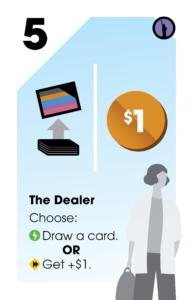
Examples
Example 1: You play ![]()
![]() . As you play your 5, you choose to draw a card. You draw a card from your deck. It’s a
. As you play your 5, you choose to draw a card. You draw a card from your deck. It’s a ![]() , and you play it.
, and you play it.
Example 2: you play ![]()
![]() . As you play your 5, you choose not to draw a card, and nudge the card up to remember you’ll get +$1. On your turn to buy, you get $2 because you played 2 cards. Then you use your 5’s patron power to get +$1.
. As you play your 5, you choose not to draw a card, and nudge the card up to remember you’ll get +$1. On your turn to buy, you get $2 because you played 2 cards. Then you use your 5’s patron power to get +$1.
How do I draw cards?
As you play your 5, if you choose to draw a card, take the top card of your deck and add it to your hand. Then continue playing cards (you may or may not be able to play the new card you drew)!
If there aren’t any cards left in your deck, shuffle your discard pile to form your new deck, and draw from that.
Tip: when possible, it’s better to draw cards closer to the start of your turn. That way you’re more likely to be able to fit the new card into the sequence of cards you’re planning on playing.
6 – The Trendoid
 As you play a 6, choose a card you’ve already played this turn. The 6 copies that card’s powers.* Great for copying 5s and 7s!
As you play a 6, choose a card you’ve already played this turn. The 6 copies that card’s powers.* Great for copying 5s and 7s!
 You also get +$1 on your turn to buy.
You also get +$1 on your turn to buy.
*This power can’t be copied.

Examples
Example 1: You play ![]()
![]()
![]() . As you play your 6, you choose to copy your 3’s powers. On your turn to buy, you get +$1 from your 6. You can trash a card with your 3’s power, and trash another card because your 6 copied your 3’s power.
. As you play your 6, you choose to copy your 3’s powers. On your turn to buy, you get +$1 from your 6. You can trash a card with your 3’s power, and trash another card because your 6 copied your 3’s power.
Example 2: you play ![]()
![]()
![]() . As you play your 6, you choose to copy your 4’s power, which immediately lets you change the 6’s color or number. You change the 6 to red so that it matches your 4. You also get +$1 from your 6 on your turn to buy.
. As you play your 6, you choose to copy your 4’s power, which immediately lets you change the 6’s color or number. You change the 6 to red so that it matches your 4. You also get +$1 from your 6 on your turn to buy.
How does copying powers work?
As you play the 6, you’ll choose a card you’ve already played this turn. Treat your 6 as if it had all of the chosen card’s powers!
If you copy a card with a ![]() power, you use it immediately as you play the 6.
power, you use it immediately as you play the 6.
If you copy a card with a ![]() power, you can use that power on your turn to buy.
power, you can use that power on your turn to buy.
Can I copy a 2 to get extra 2s?
No. A 6 copies patron powers, but doesn’t change its number. In addition, copying a 2’s patron power won’t do anything useful, because you can only use the 2’s patron power once per turn.
Can I copy a 6 with another 6?
Yes, but not completely. The 6’s “Copy another card’s patron power” power cannot be copied. But if you choose to copy a previous 6, you will get another +$1.
Example: You play ![]()
![]() . Your first 6 copies nothing, and your second 6 copies the first 6’s powers. You get $5: $2 for playing 2 cards, +$1 for your first 6, +$1 for your second 6, and +$1 for your second 6 copying your first 6.
. Your first 6 copies nothing, and your second 6 copies the first 6’s powers. You get $5: $2 for playing 2 cards, +$1 for your first 6, +$1 for your second 6, and +$1 for your second 6 copying your first 6.
7 – The Critic
 After you play a 7, draw a card from your deck. If you played a 5, 6, or 7 before this 7, draw another card.
After you play a 7, draw a card from your deck. If you played a 5, 6, or 7 before this 7, draw another card.
Tip: You can play cards you draw if they match where you left off!
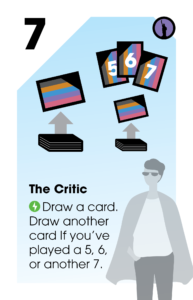
Examples
Example 1: You play ![]()
![]() . As soon as you’ve played your 7, you draw 1 card from your deck. It’s a
. As soon as you’ve played your 7, you draw 1 card from your deck. It’s a ![]() , which matches your 7, so you play it.
, which matches your 7, so you play it.
Example 2: you play ![]()
![]() . You draw a card for your first 7, then draw two cards for your second 7 (because you’ve played another 5-7 before it).
. You draw a card for your first 7, then draw two cards for your second 7 (because you’ve played another 5-7 before it).
How do I draw cards?
To draw a card, take the top card of your deck and add it to your hand. Then continue playing cards (you may or may not be able to play the new card you drew)!
If there aren’t any cards left in your deck, shuffle your discard pile to form your new deck, and draw from that.
Tip: when possible, it’s better to draw cards closer to the start of your turn. That way you’re more likely to be able to fit the new card into the sequence of cards you’re planning on playing.
If I change a 4 to a 5-7, does the 7 power draw 2 cards?
Yes! If you change a 4, it changes for all purposes other than its own patron power. Other cards (including 7s), count its number or color as whatever you changed it to.
Example: you play ![]()
![]() changing your 4 to a 6. You draw 2 cards from your 7—one card, and then another because your 4 now counts as a 5-7.
changing your 4 to a 6. You draw 2 cards from your 7—one card, and then another because your 4 now counts as a 5-7.
Note: Each patron power is optional. For each power starting with a  or
or  , you can skip it if you don’t want to use it..
, you can skip it if you don’t want to use it..
* This power can’t be copied.
 TOKYOITES
TOKYOITES
2 – The Curator
 On your turn to buy, if you have the most 2s (or tied), choose a card in your played cards or discard pile to trash (put in the box), once per turn.
On your turn to buy, if you have the most 2s (or tied), choose a card in your played cards or discard pile to trash (put in the box), once per turn.

Example
You play ![]()
![]()
![]()
![]()
![]()
![]()
![]() . At the start of your turn to buy, you have $7 because you played 7 cards. You played more 2s than any other player, so you use the power of one of your 2s to trash a 12 from your discard pile, returning it to the box.
. At the start of your turn to buy, you have $7 because you played 7 cards. You played more 2s than any other player, so you use the power of one of your 2s to trash a 12 from your discard pile, returning it to the box.
When do I check to see if I have the most 2s?
You check if you have the most 2s (or are tied for most 2s) on your turn to buy, when you choose to use the 2’s patron power.
In rare cases, the number of 2s players have may change between turns (for example, if they used the Curator). When you check, you check only the 2s that players have in front of them among the cards they played—so if another player trashed a 2 before your turn, they have one fewer when you count 2s.
It’s possible for an opponent to have the most 2s on their turn, and you to have the most 2s on your turn.
Can I trash a card from my hand?
Yes—well, kinda.
You have to discard all cards remaining in your hand before your turn to buy. So when you use your 2’s power, you can trash a card that was in your hand (and is now in your discard pile).
Why would I trash cards? Which should I trash?
Trashing cards lets you remove them from your deck so you draw cards with patron powers more frequently.
You should use this power to get rid of cards that are hard to match or have no patron powers.
Good cards to trash include your ![]()
![]() (because you can’t buy any other white or gray cards), or your 11-14 cards (because you can’t buy any other 11-14 cards, and they have no patron powers).
(because you can’t buy any other white or gray cards), or your 11-14 cards (because you can’t buy any other 11-14 cards, and they have no patron powers).
What happens if I trash a card I played?
If you choose to trash a card you played instead of trashing one from your discard pile, you keep its money (because you get money at the start of your turn to buy).
You can choose to use your ![]() powers in any order. If the card you wish to trash has a
powers in any order. If the card you wish to trash has a ![]() power, you may choose to use it before you use your 2’s power to trash it.
power, you may choose to use it before you use your 2’s power to trash it.
Do I have to trash a card?
No, all patron powers are optional.
3 – The Archivist
 After you play a 3 you may discard a card from your hand to draw a card from your deck.
After you play a 3 you may discard a card from your hand to draw a card from your deck.

Example
You play ![]() . The only card left in your hand is
. The only card left in your hand is ![]() . You discard it card, and draw
. You discard it card, and draw ![]() . You play it!
. You play it!
Do I have to discard a card?
No, all patron powers are optional. But if you don’t discard a card, you don’t get to draw a card.
How do I draw cards?
To draw a card, take the top card of your deck and add it to your hand. Then continue playing cards (you may or may not be able to play the new card you drew)!
If there aren’t any cards left in your deck, shuffle your discard pile to form your new deck, and draw from that.
Tip: when possible, it’s better to draw cards closer to the start of your turn. That way you’re more likely to be able to fit the new card into the sequence of cards you’re planning on playing.
4 – The Journalist
 The 4s are wild! Similar to The Gallerist
The 4s are wild! Similar to The Gallerist  , as you play a 4, you may change its number to 1-7. The changed 4 must match your previous (and next) card. Changing its number doesn’t change its powers.
, as you play a 4, you may change its number to 1-7. The changed 4 must match your previous (and next) card. Changing its number doesn’t change its powers.
 If it’s the first 4 you’ve played, draw a card.
If it’s the first 4 you’ve played, draw a card.
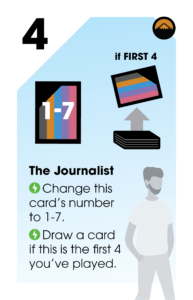
Example
You want to play ![]()
![]()
![]() . As you play your 4, you say you’re changing it to a “1.” The 4 is now an orange “1,” matching the orange card before it. Then you draw a card from your deck.
. As you play your 4, you say you’re changing it to a “1.” The 4 is now an orange “1,” matching the orange card before it. Then you draw a card from your deck.
You cannot change your 4 to a purple card, because it wouldn’t match the orange 2 before it.
After playing your ![]() you play
you play ![]() , changing it to a “1.” You don’t draw another card, because you’ve already played a 4 this turn.
, changing it to a “1.” You don’t draw another card, because you’ve already played a 4 this turn.
Do I draw a card for my first 4, even if I change its number?
Yes! It doesn’t matter what you change your 4 into—you always draw a card if you haven’t played a 4 yet this turn.
If you’ve already played a 4 this turn, you don’t draw another card, no matter what you turned that 4 into.
If I change a 4 to a ``2,`` does it count as one of my 2s for their patron power?
Yes! When you change a 4, its own patron power stays the same. For all other purposes, it has the color or number you change it to. So if you change it to a 2, other 2′ patron powers count it towards having the most 2s.
Example: you play ![]()
![]()
![]() , changing your 4 into a “2.” You use your 2’s patron power—your opponent only has one 2, and you have two, so you can trash a card.
, changing your 4 into a “2.” You use your 2’s patron power—your opponent only has one 2, and you have two, so you can trash a card.
For any other cards’ powers that check your cards’ colors or numbers, they count the card you changed your 4 into.
How do I draw cards?
To draw a card, take the top card of your deck and add it to your hand. Then continue playing cards (you may or may not be able to play the new card you drew)!
If there aren’t any cards left in your deck, shuffle your discard pile to form your new deck, and draw from that.
Tip: when possible, it’s better to draw cards closer to the start of your turn. That way you’re more likely to be able to fit the new card into the sequence of cards you’re planning on playing.
5 – The Shmoozer
 For the rest of this turn, powers that draw cards draw you an extra card.
For the rest of this turn, powers that draw cards draw you an extra card.

Example
You play a ![]() then a
then a ![]() which lets you discard a card from your hand to draw a card. You discard a card and draw two cards because of the 5s power. One of the cards you draw is a
which lets you discard a card from your hand to draw a card. You discard a card and draw two cards because of the 5s power. One of the cards you draw is a ![]() which you can play after the
which you can play after the ![]() . A 4 normally lets you draw one card but instead you draw two cards because of the
. A 4 normally lets you draw one card but instead you draw two cards because of the ![]() .
.
If I play multiple 5s, do I draw multiple bonus cards?
Yes! If you play ![]()
![]()
![]() , you’ll draw three cards.
, you’ll draw three cards.
Does it matter what order I play my cards in?
Yes. The 5’s power only works for cards you play after it this turn.
How do I draw cards?
To draw a card, take the top card of your deck and add it to your hand. Then continue playing cards (you may or may not be able to play the new card you drew)!
If there aren’t any cards left in your deck, shuffle your discard pile to form your new deck, and draw from that.
Tip: when possible, it’s better to draw cards closer to the start of your turn. That way you’re more likely to be able to fit the new card into the sequence of cards you’re planning on playing.
6 – The Investor
 On your turn to buy, you may trash one of your played cards for bonus money. If you trash a 5-7, get +$2. If you trash anything else, get +$1.
On your turn to buy, you may trash one of your played cards for bonus money. If you trash a 5-7, get +$2. If you trash anything else, get +$1.
You can’t trash this 6 with its own power.

Example
You play ![]()
![]()
![]() .
.
On your turn to buy, you use your first 6’s power to trash your 2 for +$1. You use your second 6’s power to trash your first 6 for +$2. You have $3 because you played three cards, for a total of $6 to spend.
What does it mean to trash a ``played card``?
You can only trash cards in your row of played cards, not from your discard pile. If you trash a played card, you keep its money (because you get money at the start of your turn to buy).
You can choose to use your ![]() powers in any order. If the card you wish to trash has a
powers in any order. If the card you wish to trash has a ![]() power, you may choose to use it before you use your 6’s power to trash it.
power, you may choose to use it before you use your 6’s power to trash it.
Can I trash a 6 with a 6?
Yes, but you can’t trash itself. If you played two 6s, you can trash one with the other.
(They can’t both trash each other)
Do I have to trash a card?
No, all patron powers are optional. But if you don’t trash a card, you don’t get any bonus money.
7 – The Hoarder
 After you play a 7, choose a color. For the rest of this turn, whenever you play two cards of the chosen color (counting the 7, if it’s the chosen color) draw a card from your deck.
After you play a 7, choose a color. For the rest of this turn, whenever you play two cards of the chosen color (counting the 7, if it’s the chosen color) draw a card from your deck.

Example
You play ![]() and choose red. You play
and choose red. You play ![]() and draw a card. You play
and draw a card. You play ![]() and
and ![]() then draw another card, etc.
then draw another card, etc.
Can I draw more than one card this way?
Yes! For every second card you play of the chosen color, you get to draw one card. If you have enough cards of the chosen color in your deck, you might be able to draw and play your whole deck!
What happens if I play multiple 7s?
7s can stack and each 7 counts forward from itself, so it depends on how you play them!
Example 1—You play two red 7s naming red for both of them. Now every red card you play, you draw one card:
![]()
![]() (draw for first 7’s power)
(draw for first 7’s power) ![]() (draw for second 7’s power)
(draw for second 7’s power) ![]() (draw for first 7’s power), etc.
(draw for first 7’s power), etc.
Example 2—You play one red 7 and one blue 7, both naming red. Now every second red card you play, you draw two cards:
![]()
![]()
![]() (draw two cards)
(draw two cards) ![]()
![]() (draw two cards), etc.
(draw two cards), etc.
How do I draw cards?
To draw a card, take the top card of your deck and add it to your hand. Then continue playing cards (you may or may not be able to play the new card you drew)!
If there aren’t any cards left in your deck, shuffle your discard pile to form your new deck, and draw from that.
Tip: when possible, it’s better to draw cards closer to the start of your turn. That way you’re more likely to be able to fit the new card into the sequence of cards you’re planning on playing.
Can I choose white or gray for the color?
Why would you?
No. You can only choose purple, red, blue, or orange.
In Avant Carde, gray and white don’t count as colors.
 PARISIANS
PARISIANS
Concealed Cards and Unveiling
Some powers let you play cards “Concealed.” To play a concealed card, you must first be instructed to do so by a power. Take the card and place it number side down at the end of the line of cards you are playing. Its number and color don’t matter right now; it doesn’t need to match the card before it.
Concealed cards count for nothing right now. Unlike number side up cards, they don’t give you money, and you don’t use their powers. If you have more cards to play after the concealed card, match to the card before the concealed card, as if the concealed card isn’t there.
Why play cards concealed? Because other cards’ powers may let you unveil concealed cards for bonuses! To unveil a card, choose a number side down card, and flip it number side up.
Example
You play a ![]() , and use its power to play a card concealed: you choose a card from your hand and play it number side down
, and use its power to play a card concealed: you choose a card from your hand and play it number side down ![]() . Because it’s concealed, you continue matching to the 2 before it as you play more cards like this:
. Because it’s concealed, you continue matching to the 2 before it as you play more cards like this:
![]()
![]()
![]()
![]()
(The ![]() symbol indicates a concealed—number side down—card.)
symbol indicates a concealed—number side down—card.)
When I unveil a card, do I get money for it? Can I use its powers?
It depends on when you unveil the concealed card.
If you unveil it using a ![]() power, you will get its +$1 at the start of your turn to buy, just like normal. If you unveil it using a
power, you will get its +$1 at the start of your turn to buy, just like normal. If you unveil it using a ![]() power, you will not (but most
power, you will not (but most ![]() powers that unveil cards give you +$1 as if you had).
powers that unveil cards give you +$1 as if you had).
No matter when you unveil a concealed card, you don’t get to use any of its ![]() powers (unless the unveiling card says otherwise). So long as it’s number side up at any point during your turn to buy, you can use its
powers (unless the unveiling card says otherwise). So long as it’s number side up at any point during your turn to buy, you can use its ![]() powers like normal.
powers like normal.
Can I unveil a card even if it won't match the cards on either side of it?
Yes! This is just fine—matching only matters as you play the cards, not afterwards. Unveiling a card may make it so when you look back on the cards you played, they don’t all match in sequence like normal.
2 – The Thief
 After you play a 2, you may play a card from your hand concealed.
After you play a 2, you may play a card from your hand concealed.
 If you have the most 2s (or tied) you can unveil a card to get +$1, once per turn.
If you have the most 2s (or tied) you can unveil a card to get +$1, once per turn.
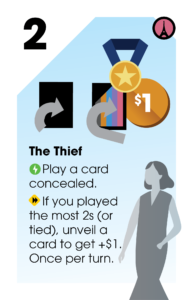
Example
You play a ![]() . You use its
. You use its ![]() power and choose a
power and choose a ![]() from your hand, playing it concealed
from your hand, playing it concealed ![]() (number side down). Then you play more blue cards from your hand. Your played cards look like this:
(number side down). Then you play more blue cards from your hand. Your played cards look like this:
![]()
![]()
![]()
![]()
On your turn to buy, you have $3 to buy with, because you have 3 cards—you don’t count the concealed one. You have the most 2s, so you use your 2’s ![]() power and unveil your concealed card (turning it number side up). The 2’s power gives you +$1, for a total of $4. Your played cards look like this:
power and unveil your concealed card (turning it number side up). The 2’s power gives you +$1, for a total of $4. Your played cards look like this:
![]()
![]()
![]()
![]()
Do I have to play a card concealed?
No, all patron powers are optional. If you can play all the cards in your hand, you may not want to play one concealed.
If I have the most 2s but don't have a concealed card, do I still get +$1?
No. In order to get the bonus, you must have a concealed card to unveil.
When do I check to see if I have the most 2s?
You check if you have the most 2s (or are tied for most 2s) on your turn to buy, when you choose to use the 2’s patron power.
In rare cases, the number of 2s players have may change between turns (for example, if they used the Curator). When you check, you check only the 2s that players have in front of them among the cards they played—so if another player trashed a 2 before your turn, they have one fewer when you count 2s.
It’s possible for an opponent to have the most 2s on their turn, and you to have the most 2s on your turn.
I have more questions about concealing or unveiling cards
For more details, see Concealed Cards and Unveiling at the top of the Parisians section.
3 – The Impersonator
 On your turn to buy you may trash one of your concealed cards.
On your turn to buy you may trash one of your concealed cards.
 On your turn to buy, choose an opponent’s card. This 3 copies and uses all of the
On your turn to buy, choose an opponent’s card. This 3 copies and uses all of the  powers on the chosen card.*
powers on the chosen card.*
*This power cannot be copied. Each 3 you play must copy a different cards’ powers.

Example
You play ![]()
![]()
![]()
![]()
![]() . On your turn to buy, you use your 3’s first power to trash one of your concealed cards leaving you with
. On your turn to buy, you use your 3’s first power to trash one of your concealed cards leaving you with ![]()
![]()
![]()
![]()
Your opponent played a 6, so you use your 3’s second power to copy the 6’s ![]() powers. These powers give you +$1, and let you unveil your remaining concealed card for another +$1.
powers. These powers give you +$1, and let you unveil your remaining concealed card for another +$1.
What happens if none of my opponents play cards that have ``Buy`` powers?
If none of your opponents played cards with ![]() powers, your 3 can’t copy anything useful. In that case, you can ignore its second power.
powers, your 3 can’t copy anything useful. In that case, you can ignore its second power.
What happens if I copy another 3?
You get to trash another of your concealed cards (assuming you have one). The 3s’ second power cannot be copied, so you don’t get to do anything else.
What happens if I copy a 2?
Not much. You get to use the 2’s ![]() power to unveil one of your concealed cards… but you can only do that if you have the most 2s, and only if you haven’t used that power on one of your 2s already. In short, it’s rarely helpful to copy a 2’s powers.
power to unveil one of your concealed cards… but you can only do that if you have the most 2s, and only if you haven’t used that power on one of your 2s already. In short, it’s rarely helpful to copy a 2’s powers.
Copying a 2’s powers doesn’t make your 3 count as an extra 2.
What happens if I play multiple 3s?
You cannot choose the same card to copy for each of your 3s.
Example: You played ![]()
![]()
![]() . You only have one opponent, and they played
. You only have one opponent, and they played ![]()
![]() . You copy their first 6 with your first 3, getting +$1. You copy their second 6 with your second 3, for another +$1. There’s nothing left for you to copy with your third 3 because you may only copy a cards’ powers once, so you don’t use your final 3s copying power.
. You copy their first 6 with your first 3, getting +$1. You copy their second 6 with your second 3, for another +$1. There’s nothing left for you to copy with your third 3 because you may only copy a cards’ powers once, so you don’t use your final 3s copying power.
I have more questions about concealing or unveiling cards
For more details, see Concealed Cards and Unveiling at the top of the Parisians section.
4 – The Conservator
 As you play a 4, choose orange, red, blue, or purple. After you play your next concealed card, it becomes that color.
As you play a 4, choose orange, red, blue, or purple. After you play your next concealed card, it becomes that color.
 Play a card from your hand concealed.
Play a card from your hand concealed.

Example
Normally, concealed cards have no color or number, and you match to the card before them as you play new cards. The Conservator lets you assign a color to a concealed card, and then match to it as if it was that color, instead.
Example: You have ![]()
![]()
![]() in your hand. You play your 4 choosing orange. You use your 4’s power to play your 1 concealed. It’s now an orange card, so you can play your 2 matching it, like this:
in your hand. You play your 4 choosing orange. You use your 4’s power to play your 1 concealed. It’s now an orange card, so you can play your 2 matching it, like this:
![]()
![]()
![]() .
.
You get $2 to buy with.
Do I have to play a card concealed? What happens if I don't?
You don’t have to play a card concealed; all patron powers are optional.
If you choose not to play a card concealed, you can still choose a color, and the next card you play concealed (from a different card’s power) will count as that color.
Example: You play ![]() and choose orange. You play
and choose orange. You play ![]() and use its power to play a concealed card
and use its power to play a concealed card ![]() . That card counts as orange, so you can play your
. That card counts as orange, so you can play your ![]() . Like this:
. Like this:
![]()
![]()
![]()
![]()
If I give my concealed card a color, can I still match to the 4 before it?
No—if a concealed card has a color, and you go to play a card after it, the card you play must match the color.
If you’d like to match to the 4 instead, you may choose not to use its first power. So long as you don’t give the concealed card a color, you match to the card before it.
5 – The Forger
 On your turn to buy, either copy a previous opponent’s buy, OR copy any one buy from an opponent later this round. Each 5 you play must copy different buys.
On your turn to buy, either copy a previous opponent’s buy, OR copy any one buy from an opponent later this round. Each 5 you play must copy different buys.

Examples
Example 1: Your opponent is the first player. On their turn to buy, they buy a 6. On your turn to buy, you use your 5’s power, and choose to copy a previous opponent’s buy. You buy the next 6 from the Gallery for free.
Example 2: You are the first player and you play a 5. On your turn to buy, you use your 5’s power and choose to copy a future buy. On the next player’s turn to buy, they buy a 2, which you choose not to copy, then a 7, which you copy. You buy the next 7 from the Gallery for free.
If I copy a buy from an opponent later this round, when do I decide what to buy?
If you choose to copy an opponent’s buy later this round, each time an opponent buys for the rest of the round, you get to see the next card in the Gallery and must immediately choose whether or not to buy it for free, or to pass.
Careful: if you pass and nobody buys any more cards, your copied buy will be wasted. You don’t get to go back and choose one of the previous things to buy.
Do I get to see the color of the card before I buy it? Can I tuck a card?
Yes, you get to see the color before you decide to buy it. Whether or not you can tuck a card though depends on when you are copying an opponents buy.
If you are copying a buy from earlier this round during your own buy phase, you can tuck a card before using this power as you normally would! This may help you get a more ideal color for your deck.
However, if you choose to copy an opponent’s buy later this round, you may not tuck before buying because you may only tuck during your turn to buy. In this case, you can only take whatever color is currently at the top of the stack.
What happens if I play multiple 5s? What happens if multiple players play 5s?
If you play multiple 5s, they can’t copy the same buy.
Example: your two opponents each buy a 7. You play three 5s. With the first 5, you copy your first opponent’s buy and get a 7 for free. With your second 5, your copy your second opponent’s buy and get another 7 for free. You have nothing left to copy with your third 5, so you don’t get any other cards for free.
If multiple players play 5s, and each choose to copy a future opponent’s buy, they copy a buy in turn order.
Example: The first player plays a 5. The second player plays a 5. The third player buys a 7. The first player chooses not to copy the buy, because the next 7 isn’t a color that they want. The second player chooses to copy the buy, and gets the next 7 for free. The first player may not longer copy this buy because it has already been copied once.
6 – The Launderer
 On your turn to buy, get +$1.
On your turn to buy, get +$1.
 On your turn to buy, you can unveil one of your concealed cards to get another +$1
On your turn to buy, you can unveil one of your concealed cards to get another +$1

Example
You play ![]()
![]()
![]() .
.
You use your 6’s first power for +$1, and then you use your 6’s second power to unveil the concealed card for +$1. Now your played cards are ![]()
![]()
![]() .
.
The concealed card was also a 6, so you use its first power for another +$1.
You have a total of $5 to buy with: $2 for your two unconcealed cards at the start of the turn, +$2 from your ![]() ‘s powers, +$1 from your unveiled
‘s powers, +$1 from your unveiled ![]() .
.
If I don't have a concealed card, do I still get the additional +$1?
No. In order to use the second power, you must have a concealed card to unveil.
I have more questions about concealing or unveiling cards
For more details, see Concealed Cards and Unveiling at the top of the Parisians section.
7 – The Completionist
 After you play a 7, you may play a card from your hand concealed. If you do, draw a card from your deck for each of the 4 colors you’ve played so far (purple, red, blue, orange), including this 7’s color.
After you play a 7, you may play a card from your hand concealed. If you do, draw a card from your deck for each of the 4 colors you’ve played so far (purple, red, blue, orange), including this 7’s color.

Example
You play ![]()
![]()
![]() . You play a card from your hand concealed, and then draw two cards: one because you’ve played an orange card, and one because you’ve played a blue card.
. You play a card from your hand concealed, and then draw two cards: one because you’ve played an orange card, and one because you’ve played a blue card.
What if I don't have any cards in my hand to play concealed? Or I don't want to?
You don’t have to play a card concealed; all powers are optional.
But if you don’t have a card to play concealed, you don’t get to draw cards.
What if I change a card's color, like with a 4?
Any cards with changed colors count as those colors for The Completionist.
Example: You play ![]()
![]()
![]()
![]()
![]() . When you play your 4, you choose that your next concealed card will be purple, but choose not to play an additional concealed card. You play a concealed card for your 7. Now you draw three cards: one for orange, one for blue, and one for purple (the concealed card is purple because of your 4’s power).
. When you play your 4, you choose that your next concealed card will be purple, but choose not to play an additional concealed card. You play a concealed card for your 7. Now you draw three cards: one for orange, one for blue, and one for purple (the concealed card is purple because of your 4’s power).
I have more questions about concealing or unveiling cards
For more details, see Concealed Cards and Unveiling at the top of the Parisians section.
* This power can’t be copied.
 LONDONERS – Micro Expansion
LONDONERS – Micro Expansion
Some Londoners patron powers conceal or unveil cards. For details about concealing and unveiling cards, see the Parisians section.
2 – The Collector
 On your turn to buy, if you have the most 2s (or tied), buy the next 2, 3, or 4 from its Gallery for free, once per turn.
On your turn to buy, if you have the most 2s (or tied), buy the next 2, 3, or 4 from its Gallery for free, once per turn.
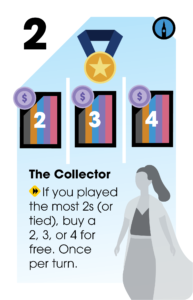
Example
You play ![]()
![]()
![]()
![]()
![]()
![]()
![]() . On your turn to buy, you have more 2s than anyone else, so you use the power of one of your 2s and buy the next 4 in the Gallery for free. You add it to your discard pile, like normal.
. On your turn to buy, you have more 2s than anyone else, so you use the power of one of your 2s and buy the next 4 in the Gallery for free. You add it to your discard pile, like normal.
When do I check to see if I have the most 2s?
You check if you have the most 2s (or are tied for most 2s) on your turn to buy, when you choose to use the 2’s patron power.
In rare cases, the number of 2s players have may change between turns (for example, if they used the Curator). When you check, you check only the 2s that players have in front of them among the cards they played—so if another player trashed a 2 before your turn, they have one fewer when you count 2s.
It’s possible for an opponent to have the most 2s on their turn, and you to have the most 2s on your turn.
3 – The Hipster
 After you play a 3, choose either to draw a card from your deck and play it concealed, OR unveil one of your concealed cards and use its
After you play a 3, choose either to draw a card from your deck and play it concealed, OR unveil one of your concealed cards and use its  powers.
powers.
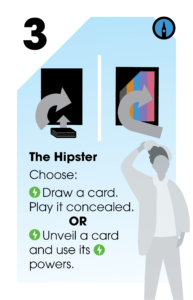
Examples
Example 1: You play a 3, and choose to draw a card and play it concealed. You draw another 3, and play it number side down. ![]()
![]()
Example 2: You’ve played a 3, and a concealed 3. You play another 3 and choose to unveil the concealed 3 before it: ![]()
![]()
![]()
![]()
![]()
![]()
![]()
![]()
![]()
![]()
When you unveil it, you choose to use its power and draw another card and play it concealed: ![]()
![]()
![]()
![]()
Why would I want to draw a card and play it concealed?
Usually so you can unveil it later with another card’s power, like another 3’s power!
If I unveil a card with a 3, do I get money for it?
Yes! Since this is a ![]() power, the card you unveil will be number side up at the start of your turn to buy. That means that you count it as $1, and can use any of its
power, the card you unveil will be number side up at the start of your turn to buy. That means that you count it as $1, and can use any of its ![]() powers like normal.
powers like normal.
What does ``use their powers`` mean?
If the card you unveil has any ![]() powers, the 3’s power lets you use those powers immediately, as if you had just played the unveiled card.
powers, the 3’s power lets you use those powers immediately, as if you had just played the unveiled card.
(Normally, unveiling cards does not let you use their ![]() powers.)
powers.)
Can I look at my concealed cards?
Yes! When you draw the card you can look at it before you play it concealed. You can also always peek at your concealed cards.
4 – The Philosopher
 As you play a 4, choose an odd number. The 4 counts as the chosen odd number as well as a 4. It can match with cards of the chosen odd number, 4s, or cards of its color. This doesn’t change the 4’s patron powers.
As you play a 4, choose an odd number. The 4 counts as the chosen odd number as well as a 4. It can match with cards of the chosen odd number, 4s, or cards of its color. This doesn’t change the 4’s patron powers.
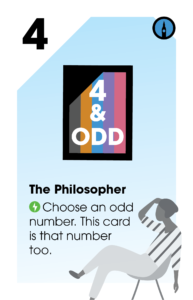
Example
You play a 4 and choose “13.” Now you can match your 13 to the 4:
![]()
![]()
![]()
Why would want to make a 4 an odd number?
Usually, you want to use this power to allow you to match with a card in your hand whose color or number you otherwise wouldn’t be able to match with, like a wild!
In addition, for any other cards’ powers that check your cards’ numbers, they count the 4 as the odd number as well. (For example, 7 The Eccentric patron power will count your 4 as the odd number as well as a 4)
5 – The Futurist
 On your turn to buy, get +$1 if this is the final card in your line.
On your turn to buy, get +$1 if this is the final card in your line.
 Choose to either: Trash a card from your discard or played cards, OR conceal a card you’ve played (flip it number side down; you still keep its money).
Choose to either: Trash a card from your discard or played cards, OR conceal a card you’ve played (flip it number side down; you still keep its money).
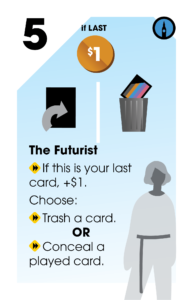
Example
You played ![]()
![]()
![]()
On your turn to buy, you use your blue 5’s power to get +$1, because it’s your final card. You can’t use your pink 5 to get bonus money, because it’s not last. You have a total of $4 to buy with.
Then you use both of your 5s’ second powers to trash 2 cards from your discard pile.
Why would I want to conceal one of my played cards?
If you conceal a card, it basically doesn’t count among your played cards. This means a 5 with a concealed card after it is still last!
Example: You played ![]()
![]()
![]()
On your turn to buy, you use your blue 5’s power to get +$1 (because it’s last), and trash a card in your discard. Then you use your pink 5’s power to conceal your blue 5 giving you ![]()
![]()
![]()
Because your pink 5 is now the last card in your line, you use its power to get +$1. You have a total of $5 to buy with.
(If you conceal a card during your turn to buy, you keep its money, because you get money at the start of your turn to buy)
Can I trash a card from my hand?
Yes—well, kinda.
You have to discard all cards remaining in your hand before your turn to buy. So when you use your 5’s power, you can trash a card that was in your hand (and is now in your discard pile).
What happens if I trash a card I played?
If you choose to trash a card you played instead of trashing one from your discard pile, you keep its money (because you get money at the start of your turn to buy).
You can choose to use your ![]() powers in any order. If the card you wish to trash has a
powers in any order. If the card you wish to trash has a ![]() power, you may choose to use it before you use your 5’s power to trash it.
power, you may choose to use it before you use your 5’s power to trash it.
Do I have to trash or conceal a card?
No, each patron power is optional. You can still get +$1 if your 5 is last, even if you choose not to trash or conceal a card.
6 – The Designer
Each card has double its powers!
 For the rest of the turn after playing a 6, whenever you use a card’s
For the rest of the turn after playing a 6, whenever you use a card’s  or
or  patron power, copy it. This power can’t be copied.
patron power, copy it. This power can’t be copied.
*This power can’t be copied.
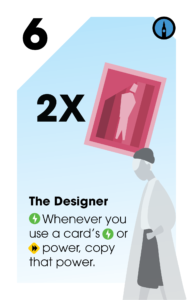
Example
You play ![]()
![]() . You use your 3’s
. You use your 3’s ![]() power to draw a card and play it concealed. Then you copy the 3’s power and preform it again because of your 6’s power, drawing another card and playing it concealed.
power to draw a card and play it concealed. Then you copy the 3’s power and preform it again because of your 6’s power, drawing another card and playing it concealed.
What happens if I play multiple 6s?
If you’ve played one 6, powers happen twice. If you have played two 6s, powers happen three times.
Note: This power itself cannot be copied. So playing a 6 and then another 6 doesn’t copy the second 6’s power.
When I copy a power, do I have to make the exact same choices with the copy?
No! You can make different decisions for each copy.
Example 1: You play ![]()
![]() . For your 3’s power, you choose to draw a card and play it concealed. Then for the copy, you choose the 3’s other power and unveil the concealed card. If the unveiled card has a
. For your 3’s power, you choose to draw a card and play it concealed. Then for the copy, you choose the 3’s other power and unveil the concealed card. If the unveiled card has a ![]() power, you get to use it, and copy it!
power, you get to use it, and copy it!
Example 2: You play ![]()
![]() . Using your 4’s power, you choose an odd number to make the 4 count as in addition to being a 4. You make it a “1.” Using the 6’s copy power, you also choose to make it a “13.” Now the 4 counts as a 4, a 1, and a 13!
. Using your 4’s power, you choose an odd number to make the 4 count as in addition to being a 4. You make it a “1.” Using the 6’s copy power, you also choose to make it a “13.” Now the 4 counts as a 4, a 1, and a 13!
What happens when I copy a 2's patron power?
Nothing. Because 2s’ patron powers can only be used once per turn, copying them has no effect.
7 – The Eccentric
 On your turn to buy, conceal a card you’ve played (flip it number side down). For each remaining card in your line that shares a number with the concealed card, get +$1.
On your turn to buy, conceal a card you’ve played (flip it number side down). For each remaining card in your line that shares a number with the concealed card, get +$1.

Example
You played ![]() . On your turn to buy, you use your 7’s power to conceal the
. On your turn to buy, you use your 7’s power to conceal the ![]() , then get +$2 ($1 for each remaining 3).
, then get +$2 ($1 for each remaining 3).
You have a total of $6 to buy with: $4 for playing four cards, +$2 from your 7’s power.
Note: Unlike most other powers that conceal, The Eccentric has you choose a card you’ve already played to conceal (instead of playing a card from your hand concealed).
How does this power work with cards that change their numbers, like 4s?
If you conceal a 4 that is also an odd number, you count any 4, and any card that has its odd number.
Example: you played ![]()
![]()
![]()
![]()
![]()
![]() . You chose to make your
. You chose to make your ![]() into a 3.
into a 3.
On your turn to buy, you have +$1 for each of the played cards shown above for an initial total of $9. Then you use your 7’s power and conceal your ![]() giving you
giving you ![]()
![]()
![]()
![]()
![]()
![]() . The 7’s power gives you an additional +$3 (+$1 for each of the 3s, and +$1 for the remaining 4), for a final total of $9.
. The 7’s power gives you an additional +$3 (+$1 for each of the 3s, and +$1 for the remaining 4), for a final total of $9.
When I conceal a card I've played, do I keep its money? Can I use its powers?
When you conceal a card you’ve played, you keep its money (because you get money at the start of your turn to buy).
You can choose to use your ![]() powers in any order. If the card you wish to conceal has a
powers in any order. If the card you wish to conceal has a ![]() power, you may choose to use it before you use your 7’s power to conceal it.
power, you may choose to use it before you use your 7’s power to conceal it.
Do I have to conceal a card?
No, each patron power is optional. But if you don’t conceal a card (or don’t have a card to conceal), you don’t get any bonus money.
* This power can’t be copied.
 SINGAPOREANS – Micro Expansion
SINGAPOREANS – Micro Expansion
Upgrading and Resources
Some Singaporean patron powers give you a new resource, the upgrade resource  . Resources, like money, can accumulate over the course of your turn, and are spent in specific ways. If you don’t spend them, they vanish at the end of your turn.
. Resources, like money, can accumulate over the course of your turn, and are spent in specific ways. If you don’t spend them, they vanish at the end of your turn.
On your turn to buy, you can spend upgrade resources  to: return a card from your discard or played cards to the bottom of its Gallery Stack (1s or 11-14 go to the box). Then, take the top card of the Stack one number higher than the upgraded card and add it to your discard.
to: return a card from your discard or played cards to the bottom of its Gallery Stack (1s or 11-14 go to the box). Then, take the top card of the Stack one number higher than the upgraded card and add it to your discard.
You can spend multiple  to upgrade a card several steps at once (skip the middle Stacks). 11-14s upgrade to 2s.
to upgrade a card several steps at once (skip the middle Stacks). 11-14s upgrade to 2s.
Example
You played the most 2s, so you use their power to get an upgrade resource ![]() .
.
You spend the upgrade resource to upgrade the ![]() you played. You put it on the bottom of the 2s Gallery Stack in the center of the table, then take the top 3 from the 3s Gallery Stack, and add it to your discard pile.
you played. You put it on the bottom of the 2s Gallery Stack in the center of the table, then take the top 3 from the 3s Gallery Stack, and add it to your discard pile.
Can I upgrade cards from my starting deck? Like 1s, 11-14s, and 2s?
Yes! If you upgrade a 1, return it to the box, and take the top 2 of the 2s Gallery Stack. You can upgrade 11-14s as if they were 1s. If you upgrade a 2 from your starter deck, return it to the 2s Gallery Stack (even if it’s gray! Someobdy could buy it later). Just remember to get your starter deck cards back at the end of the game!
Can I still upgrade if a Gallery Stack runs out?
No. If a Gallery Stack runs out, you can’t upgrade a card into that number. For example, if the 2s ran out, you couldn’t upgrade a 1 into a 2. But you could spend 2 upgrades ![]()
![]() to upgrade the 1 into a 3!
to upgrade the 1 into a 3!
In addition, you cannot upgrade a 7 (except when using the power of The Negotiator – 6)
Can I upgrade a card I bought this turn?
Yes! For example, you can buy a 5, place it in your discard pile as normal, and then spend a ![]() to upgrade it into a 6.
to upgrade it into a 6.
2 – The Trader
 If you played the most 2s (or tied) get 1 upgrade
If you played the most 2s (or tied) get 1 upgrade  . Once per turn
. Once per turn

Example
You play ![]()
![]()
![]()
![]()
![]()
![]()
![]() . On your turn to buy, you have more 2s than anyone else, so you use the power of one of your 2s and get a
. On your turn to buy, you have more 2s than anyone else, so you use the power of one of your 2s and get a ![]() . Later in your turn, you spend your
. Later in your turn, you spend your ![]() to upgrade a 1 that you discarded into a 2.
to upgrade a 1 that you discarded into a 2.
See details about upgrading, above.
When do I check to see if I have the most 2s?
You check if you have the most 2s (or are tied for most 2s) on your turn to buy, when you choose to use the 2’s patron power.
In rare cases, the number of 2s players have may change between turns (for example, if they upgraded a 2 that they played). When you check, you check only the 2s that players have in front of them among the cards they played—so if another player upgraded a 2 before your turn, they have one fewer when you count 2s.
It’s possible for an opponent to have the most 2s on their turn, and you to have the most 2s on your turn.
What does “once per turn” mean?
Normally in Avant Carde, every time you play a card, you get to use its patron power. For example, if you played four 3s, you’d get to use the 3 power four times.
Powers labeled “once per turn” are an exception. These powers can only be used up to once each turn, no matter how many copies of the card you play, or how many times you copy the power.
No matter how many 2s you play, you only get one upgrade resource ![]() , because you can only use one of their powers (and only if you have the most 2s).
, because you can only use one of their powers (and only if you have the most 2s).
3 – The Gambler
 Change this card’s number to 1-5.The changed 3 must match your previous (and next) card. Changing its number doesn’t change its powers.
Change this card’s number to 1-5.The changed 3 must match your previous (and next) card. Changing its number doesn’t change its powers.
 Gamble – Draw a card. If it matches the last of your played cards, play it and get +$1. Otherwise discard it.
Gamble – Draw a card. If it matches the last of your played cards, play it and get +$1. Otherwise discard it.
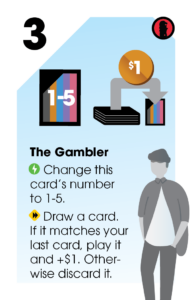
Examples
You want to play ![]()
![]()
![]() . You play your 1. As you play your 3, you say you’re changing it to a “1” using the 3’s
. You play your 1. As you play your 3, you say you’re changing it to a “1” using the 3’s ![]() power. The 3 is now an orange “1,” matching the 1 before it. Now you can play your 2.
power. The 3 is now an orange “1,” matching the 1 before it. Now you can play your 2.
On your turn to buy, you use the 3’s ![]() gamble power. You draw a
gamble power. You draw a ![]() , which matches the final 2 in your played cards, so you play it. You have $4 to buy with: $3 for the three played cards you started your turn with, and $1 additional from the gamble power.
, which matches the final 2 in your played cards, so you play it. You have $4 to buy with: $3 for the three played cards you started your turn with, and $1 additional from the gamble power.
If I change a 3 to a ``2,`` does it count as one of my 2s for their patron power? What about a ``4``? What about upgrading?
How much money do I get if I successfully gamble?
You get $1 more than you had at the start of your turn. (If you recount your cards, the number of cards should equal the amount of money)
When you successfully match using the gambling power, it’s too late to get extra money for just playing more cards, so the gambling power gives you +$1 to compensate.
When I successfully gamble, do I get to use the new card's powers?
If the card you draw has any ![]() powers, it’s too late to use those. But if the card you draw has any
powers, it’s too late to use those. But if the card you draw has any ![]() powers, you can use those after you play it.
powers, you can use those after you play it.
Example: you played a single ![]() . When you gamble, you draw another
. When you gamble, you draw another ![]() (which matches, so you play it). You can’t use the new 3’s
(which matches, so you play it). You can’t use the new 3’s ![]() power to change it into a “2.” But you can use it’s
power to change it into a “2.” But you can use it’s ![]() power to gamble again!
power to gamble again!
Can the last of my played cards change before I gamble?
Yes! In rare cases, you may choose to upgrade your last played card. In this case, when you gamble, you’re attempting to match the remaining final card in your row of played cards.
Similarly, if you are gambling multiple times, each time you’re attempting to match the current final card in your row of played cards. Depending on how successful your gambling is, the final card may change between each gamble.
4 – The Protester
 Raise the limit of powers labeled ‘once per turn’ (2s, 5s, 6s and 7s) to up to twice this turn.
Raise the limit of powers labeled ‘once per turn’ (2s, 5s, 6s and 7s) to up to twice this turn.
 If you have played three or more 4s, get +$1.
If you have played three or more 4s, get +$1.
Tip: If you play three 4s, play your 4s a little above your other cards to help you remember you’re getting +$1 from each, like this: ![]()

Example
Example 1: you play ![]()
![]()
![]()
![]() . You get $8 total: $4 for playing four cards, and each 4 gives +$1 because you have at least three 4s.
. You get $8 total: $4 for playing four cards, and each 4 gives +$1 because you have at least three 4s.
Example 2: you play ![]()
![]()
![]()
![]() . The 7s have the power: “get a bonus award, once per turn.” Normally, you’d be able to get one bonus award. But because you played a 4, you’re allowed to use that power twice this turn, and get 2 bonus awards instead.
. The 7s have the power: “get a bonus award, once per turn.” Normally, you’d be able to get one bonus award. But because you played a 4, you’re allowed to use that power twice this turn, and get 2 bonus awards instead.
What does ``Once Per Turn`` mean? What does ``Twice Per Turn`` mean?
Normally in Avant Carde, every time you play a card, you get to use its patron power. For example, if you played four 3s, you’d get to use the 3 power four times.
Powers labeled “once per turn” are an exception. These powers can only be used up to once each turn, no matter how many copies of the card you play, or how many times you copy the power.
When you play The Protester, any cards you play for the rest of the turn with “once per turn” powers (2s, 5s, 6s, 7s) have the limit raised to twice per turn. If you play at least two of a card with a “once per turn” power, you can use that power twice.
For example, 7s have the power “Get one bonus award, once per turn:”
- You play

 . You get one bonus award because the power can only be used once per turn.
. You get one bonus award because the power can only be used once per turn. - You play

 . You get one bonus award, because you played a 7.
. You get one bonus award, because you played a 7. - You play


 . You get two bonus awards because the limit is now twice per turn.
. You get two bonus awards because the limit is now twice per turn. - You play



 . You get two bonus awards because the limit is twice per turn.
. You get two bonus awards because the limit is twice per turn.
Does it matter what order I play my 4s?
Not usually. As long as you’ve played a 4, all of your ![]() “once per turn” powers can be used up to twice per turn on your turn to buy.
“once per turn” powers can be used up to twice per turn on your turn to buy.
Exception: The Promoter (5)’s “once per turn” power lets you draw 2 cards (and lose $1) when you play the card. As long as you haven’t played a 4, that power can only be used once per turn.
For example, you play:


 . You draw 2 cards, once, because you played the 4 after you played the second 5.
. You draw 2 cards, once, because you played the 4 after you played the second 5.

 . You draw 4 cards total. Two for each of the two 5s.
. You draw 4 cards total. Two for each of the two 5s.
5 – The Promoter
 After you play a 5, choose either to draw 2 cards from your deck now and lose $1 at the start of your turn to buy (once per turn),
After you play a 5, choose either to draw 2 cards from your deck now and lose $1 at the start of your turn to buy (once per turn),
OR
 whenever you buy a card this turn, this card copies and lets you use its
whenever you buy a card this turn, this card copies and lets you use its  powers immediately*.
powers immediately*.
Tip: If you choose to get draw cards and lose $1, play your 5 a little below your other cards to help you remember, like this: ![]()
*This power can’t be copied.

Example
Example 1: you play a 5 and choose to draw 2 cards. You play five more cards. On your turn to buy, you get $5 ($1 for each of your cards, then -$1 from the 5’s power). You don’t get any awards.
Example 2: you play two 5s and choose to have them both use their ![]() power. On your turn to buy, you buy a 3. You get to use its gambling power twice, right now! You buy another 3, and use the gambling power twice, again!
power. On your turn to buy, you buy a 3. You get to use its gambling power twice, right now! You buy another 3, and use the gambling power twice, again!
What happens if I play multiple 5s?
The 5’s first power is “once per turn.” This means if you play two 5s, only one of them can give you the drawing cards power (unless you’ve played a 4).
If you play two 5s and choose the second power for each, whenever you buy a card this turn you’ll get to use its ![]() powers twice!
powers twice!
Note: You can’t get around powers that are labeled “once per turn” by copying them. It still counts as the same power.
If I choose the second power, does it happen when I upgrade cards?
No. The 5’s ![]() power only happens when you buy a card, not when you upgrade a card.
power only happens when you buy a card, not when you upgrade a card.
When do I check to see how much money I have for getting awards?
Any one time you could use a ![]() power (during your turn to buy), you can choose to check how much money you currently have unspent, and collect award(s) based on that number.
power (during your turn to buy), you can choose to check how much money you currently have unspent, and collect award(s) based on that number.
Because the 5’s second power can change how much money you have after buying, you have to decide whether to check for awards before or after buying. In almost all cases, it’s better to check before you’ve spent money buying.
6 – The Negotiator
 You can spend
You can spend  to upgrade a 7 this turn and get an award. Once per turn.
to upgrade a 7 this turn and get an award. Once per turn.
 Get 2 upgrades
Get 2 upgrades  .
.

Example
Example 1: You play a 6. You spend your ![]()
![]() to upgrade a 1 and an 11 from your discard pile to two 2s.
to upgrade a 1 and an 11 from your discard pile to two 2s.
Example 2: You play a 6. You spend ![]()
![]() to upgrade the 6 you just played into an award. The 6 goes to the bottom of its Gallery Stack and you take an award from the Awards Stack and add it to your score pile.
to upgrade the 6 you just played into an award. The 6 goes to the bottom of its Gallery Stack and you take an award from the Awards Stack and add it to your score pile.
How does upgrading a 7 to an award work?
Normally, you can’t upgrade 7s.
If you play a 6, once for the rest of this turn you can treat the Awards Stack as one number higher than a 7. So if you upgrade a 7, it goes to the bottom of its stack, and you take an award and add it to your score pile.
You can alternatively spend ![]()
![]() to upgrade a 6 to an award. Or
to upgrade a 6 to an award. Or ![]()
![]()
![]() to upgrade a 5 to an award, etc. You can only get 1 award this way per turn.
to upgrade a 5 to an award, etc. You can only get 1 award this way per turn.
What does ``once per turn`` mean?
Normally in Avant Carde, every time you play a card, you get to use its patron power. For example, if you played four 3s, you’d get to use the 3 power four times.
Powers labeled “once per turn” are an exception. No matter how many 6s you play, you can only upgrade into 1 award per turn. (This limit can be raised to twice per turn if you play a 4)
7 – The Fast-Talker
 On your turn to buy, take a bonus award from the Awards Stack and add it to your score pile. Once per turn.
On your turn to buy, take a bonus award from the Awards Stack and add it to your score pile. Once per turn.
 On your turn to buy, tuck up to 2 additional cards.
On your turn to buy, tuck up to 2 additional cards.

Example
You play two 7s. You get one bonus award, taking it from the Award Stack and adding it to your score pile. Then you tuck five times before you buy.
What does ``once per turn`` mean?
Normally in Avant Carde, every time you play a card, you get to use its patron power. For example, if you played four 3s, you’d get to use the 3 power four times.
Powers labeled “once per turn” are an exception. No matter how many 7s you play, you can only get one bonus award. (This limit can be raised to twice per turn if you play a 4)
* This power can’t be copied.
Solo Rules
The solo mode plays just like the multiplayer version with the following exceptions:
SETUP
-
Place the First Player Token on the left-most section of the unrolled Gallery Box (the Change Token section).
-
Put out awards based on your desired difficulty, and return the rest to the box:
Easy
Normal
Hard
Expert
8 Awards
12 Awards
16 Awards
20 Awards
GAMEPLAY
-
At the end of each round, move the First Player Token right, to the next section in the Gallery (2s section, to 3s, 3s to 4s, etc.).
-
When you move the First Player Token, tuck the top card of the Stack and place the Token on top of it.
-
When you buy cards, you can’t buy from the Stack with the First Player Token. This doesn’t stop you from getting Change Tokens or awards.
-
You can tuck two cards per turn instead of just one.
ENDING THE GAME
If you ever take the last award in the Awards Stack, you immediately win!
At the end of the 9th round (the round where the First Player Token is on the “Extras” section), the game is over. If you didn’t get all the awards, you lose and the gallery wins.
PATRON POWERS
To have the “most 2s” for the 2 patron powers, you must have more 2s than the most prevalent color among the top cards of the Gallery Stacks (or tie). For The Impersonator (3  ) and The Forger (5
) and The Forger (5  ), check the number card that the First Player Token is on. 3
), check the number card that the First Player Token is on. 3 lets you copy its powers. 5
lets you copy its powers. 5 lets you buy it.
lets you buy it.
MOST 2s EXAMPLE:
The top cards of the Gallery Stacks look like this:
The most prevalent color is red, with 3 red cards. So you need to play three or more 2s to use their power.
Return the Hidden Gem Token to the box. It won’t be used in the solo mode.
FAQ
Can I look at all the cards in the Gallery stacks?
You may only look at each stack’s top card. Keep the stacks straight so you can’t see the next card, or flip the stacks face down and flip the top cards up.
How do I make it so I can play lots of cards?
Try choosing 2 colors and don’t buy any cards that aren’t those colors. Also try buying 3s (which let you trash cards), and trash your ![]() and
and ![]() and high number cards (11-14).
and high number cards (11-14).
If I trash a card I played, do I still get its money and its power?
Yes! Each card you play gives you $1 as you start your turn to buy. Then you can use your cards’ ![]() powers in any order (and also buy, tuck, and claim awards in any order).
powers in any order (and also buy, tuck, and claim awards in any order).
Can I save money between turns?
No. Any money you don’t spend goes away at the end of your turn. If you don’t spend all your money you get 1 Change Token (if you don’t already have one and you didn’t spend one this turn).
What happens when my deck runs out?
If there are no cards in your deck don’t do anything. But as soon as you need to draw a card, flip your discard pile over and shuffle it. It’s your new deck.
Do I have to tuck a card each turn? When can I tuck a card?
Tucking a card is optional. You may tuck a card up to once during your turn to buy, before, after, or between buying cards and using your patron powers.
Some patron powers allow you to tuck extra cards. You can do each of your tucks separately.
Do I have to spend my Change token to have it count towards awards?
You have to spend the token, but not the money. To use a Change token, you spend it to the middle of the table, and add +$1 to your total. If this pushes you to $6 (or another award threshold), take your awards. You still get the award if you don’t spend the $1 you got from the Change token (for example, if you chose to buy a 5).
Game Design: Mary Flanagan & Max Seidman • lllustration: Ishita Banerjee • Graphic Design: Michael Parla & Kayleigh Jones • Web Instructions: Kayleigh Jones • Community Management: Olivia Lothary • Logistics: Max Seidman, Danielle Taylor, & Sukdith Punjasthitkul • Art Intern: Cass Gordon • 3D Sculptor: Patrick Fahy • How to Play Video: Kovray • Playtesting: Joshua Po, Ainsley Carter, Alex Munson, Ash Chinta, Yikei Liu, Fritz Wallace, Matt Golec, & Ryan Lockwood
Special Thanks: Game Makers Guild, UV Game Designers, Resonym Discord



